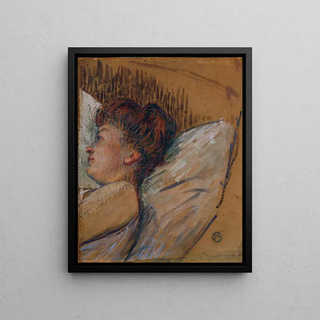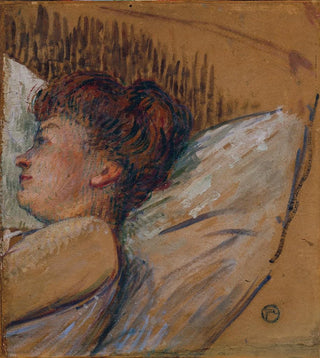Art print | Woman in bed - Henri de Toulouse-Lautrec


View from behind

Frame (optional)
The canvas "Femme au lit" by Henri de Toulouse-Lautrec presents itself as an open window into the intimacy of a world where beauty and melancholy intertwine. The artwork, painted at the end of the 19th century, captures a fleeting moment, a pause amidst the frenzy of Parisian life. The artist, known for his depictions of cabarets and scenes of nightlife, invites us here to delve into the personal universe of a woman, lying on her bed, in a posture that is both relaxed and laden with meaning. This painting, imbued with poetry, transports us to a space where time seems suspended, revealing the hidden emotions behind a simple moment of rest.
Style and uniqueness of the work
Toulouse-Lautrec's technique is distinguished by its ability to capture expressions and atmospheres with rare intensity. In "Femme au lit," warm colors and fluid lines combine to create an atmosphere that is both intimate and universal. The artist uses shades of red and beige that envelop the scene in an almost tactile softness. Each brushstroke seems to be imbued with the sensuality and vulnerability of its subject. The composition, though simple, is of great richness, each element carefully thought out to guide the viewer's gaze toward the woman's face, whose melancholic expression evokes feelings of solitude and desire. This painting, far from being a mere representation, becomes an exploration of themes of love, solitude, and the female condition.
The artist and his influence
Henri de Toulouse-Lautrec, often considered one of the pioneers of the modern movement, transcended his era with his unique vision of Parisian life. Born into an aristocratic family, he was confronted from a young age with the realities of the artistic world, shaping his critical and empathetic perspective on society. His work is marked by a deep understanding of the characters he depicts, whether they are cancan dancers, prostitutes, or figures of high society. "Femme au lit" fits into this lineage, revealing not only the beauty

Matte finish

View from behind

Frame (optional)
The canvas "Femme au lit" by Henri de Toulouse-Lautrec presents itself as an open window into the intimacy of a world where beauty and melancholy intertwine. The artwork, painted at the end of the 19th century, captures a fleeting moment, a pause amidst the frenzy of Parisian life. The artist, known for his depictions of cabarets and scenes of nightlife, invites us here to delve into the personal universe of a woman, lying on her bed, in a posture that is both relaxed and laden with meaning. This painting, imbued with poetry, transports us to a space where time seems suspended, revealing the hidden emotions behind a simple moment of rest.
Style and uniqueness of the work
Toulouse-Lautrec's technique is distinguished by its ability to capture expressions and atmospheres with rare intensity. In "Femme au lit," warm colors and fluid lines combine to create an atmosphere that is both intimate and universal. The artist uses shades of red and beige that envelop the scene in an almost tactile softness. Each brushstroke seems to be imbued with the sensuality and vulnerability of its subject. The composition, though simple, is of great richness, each element carefully thought out to guide the viewer's gaze toward the woman's face, whose melancholic expression evokes feelings of solitude and desire. This painting, far from being a mere representation, becomes an exploration of themes of love, solitude, and the female condition.
The artist and his influence
Henri de Toulouse-Lautrec, often considered one of the pioneers of the modern movement, transcended his era with his unique vision of Parisian life. Born into an aristocratic family, he was confronted from a young age with the realities of the artistic world, shaping his critical and empathetic perspective on society. His work is marked by a deep understanding of the characters he depicts, whether they are cancan dancers, prostitutes, or figures of high society. "Femme au lit" fits into this lineage, revealing not only the beauty






